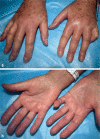Raynaud's Phenomenon: A Vascular Acrosyndrome That Requires Long-Term Care
- PMID: 33632387
- PMCID: PMC8287761
- DOI: 10.3238/arztebl.m2021.0023
Raynaud's Phenomenon: A Vascular Acrosyndrome That Requires Long-Term Care
Abstract
Background: Some 5-10% of the German population are affected by Raynaud's phenomenon (RP). In around 10-20% of cases RP arises from an underlying disease, most commonly a connective tissue disease. This review encompasses the diagnosis and differential diagnosis of RP and examines the efficacy of the currently available pharmaceutical and non-pharmaceutical treatment options.
Methods: We conducted a selective literature search in PubMed using the search terms "Raynaud's phenomenon", "Raynaud's syndrome," "vasospasm," "vascular acrosyndrome," and "systemic sclerosis," together with a search of the Cochrane Database of Systematic Reviews up to April 2020.
Results: Raynaud's phenomenon mainly affects the fingers or toes and is typically triggered by cold or emotional stressors. The most important diagnostic steps are demonstration of a tendency towards digital vasospasm, exclusion of occlusions in the afferent arteries and acral vessels, nail-fold capillaroscopy, and determination of autoantibody status. Tumor screening should be arranged in the presence of B symptoms or first manifestation of RP in old age. The onset of RP in childhood is a rare occurrence and points to a secondary origin. The principal options for treatment are protection against cold and administration of calcium antagonists, which reduces the occurrence of RP by around 20-40 %. The treatment of RP in patients with systemic sclerosis is described in the recommendations of the European League Against Rheumatism (EULAR).
Conclusion: At onset or after years of latency, patients with Raynaud phenomenon may have an underlying disease (most commonly a connective tissue disease). Long-term specialist care is necessary for asymptomatic patients with risk factors and for those with clinically manifest symptoms of an underlying condition alike.
Figures




Comment in
-
Incomplete Description.Dtsch Arztebl Int. 2021 Sep 6;118I processed the file.I'm waiting for feedback tomorrow(35-36):604. doi: 10.3238/arztebl.m2021.0281. Dtsch Arztebl Int. 2021. PMID: 34789377 Free PMC article. No abstract available.
-
Percutaneous Thoracic Sympathicolysis.Dtsch Arztebl Int. 2021 Sep 6;118I processed the file.I'm waiting for feedback tomorrow(35-36):604. doi: 10.3238/arztebl.m2021.0283. Dtsch Arztebl Int. 2021. PMID: 34789378 Free PMC article. No abstract available.
-
Raynaud's Phenomenon in the Breast Nipple Area.Dtsch Arztebl Int. 2021 Sep 6;118I processed the file.I'm waiting for feedback tomorrow(35-36):605. doi: 10.3238/arztebl.m2021.0282. Dtsch Arztebl Int. 2021. PMID: 34789379 Free PMC article. No abstract available.
References
-
- Belch J, Carlizza A, Carpentier PH, et al. ESVM guidelines - the diagnosis and management of Raynaud‘s phenomenon. Vasa. 2017;46:413–423. - PubMed
-
- Heidrich H, Helmis J, Fahrig C, et al. Clinical characteristics of primary, secondary and suspected secondary Raynaud’s syndrome and diagnostic transition in the long-term follow-up. A retrospective study in900 patients. VASA. 2008;37:S2–S25.
-
- Hirschl M, Hirschl K, Lenz M, et al. Transition from primary Raynaud‘s phenomenon to secondary Raynaud‘s phenomenon identified by diagnosis of an associated disease: results of ten years of prospective surveillance. Arthritis Rheum. 2006;54:1974–1981. - PubMed
-
- Weigel I, Klein-Weigel P, Kinzl J, et al. Psychometrische Untersuchungen an Tiroler Patienten mit Raynaud Phänomen. Wien Med Wochenschr. 2006;156:574–582. - PubMed
LinkOut - more resources
Full Text Sources
Other Literature Sources
Miscellaneous

